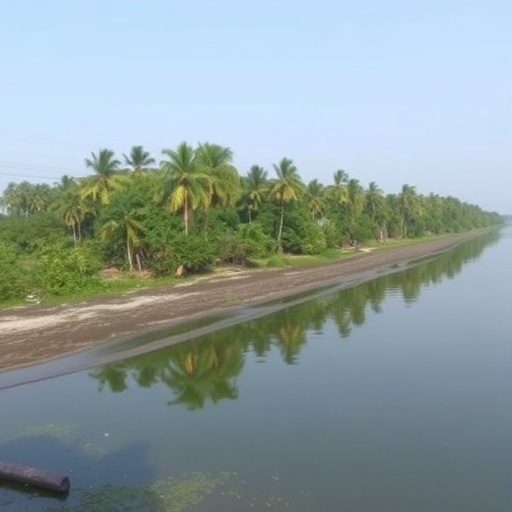The Sundarbans, a UNESCO World Heritage site, is a crucial ecological treasure located in Bangladesh, where the Bay of Bengal meets the Ganges, Brahmaputra, and Meghna rivers. This region is not just a haven for biodiversity but also a critical buffer for climate impacts. Recent research, titled “Salinity dynamics in the Sundarbans of Bangladesh: influence of climate, freshwater inflow, and sea level changes” by Wahid et al., delves into the intricate salinity patterns within this unique environment.
As sea levels rise and climatic variances become more pronounced, understanding the salinity dynamics in the Sundarbans has become increasingly vital. Salinity, a central element influencing the ecosystem, affects both flora and fauna. The balance of salt and freshwater is essential not only for the sustenance of local plant life but also for the myriad species that depend on these ecosystems for survival. The study sheds light on how these changes can affect the mangroves, fish populations, and, consequently, local human communities dependent on these resources.
Moreover, the research outlines the historical context and current trends in freshwater inflow into the Sundarbans. As the glaciers in the Himalayas continue to retreat due to rising temperatures, the freshwater that usually nourished the Sundarbans’ rivers is diminishing. This outcome presents a double-edged sword: while some areas may experience temporary increases in salinity from high tides, others may suffer from reduced freshwater availability, leading to more permanent salinification of certain habitats.
The researchers employed a combination of remote sensing data, historical records, and field studies to analyze salinity levels across various regions of the Sundarbans. Their findings indicate alarming trends, particularly in areas furthest from the freshwater outlets. In contrast, locations closer to the river mouths still exhibit viable freshwater signatures but show signs of encroachment from saline waters. These results highlight the complexity of the interactions between land, water, and climate systems in the Sundarbans.
Another dimension of the study is the socio-economic impact of salinity dynamics on local communities. Many inhabitants of the Sundarbans rely on agriculture and fishing for their livelihoods. Increased salinity alters the agricultural landscape, threatening rice production, a staple crop, and crucial for food security in the region. Furthermore, changes in fish migratory patterns due to altered salinity levels could impact local fisheries, leading to economic ramifications for families dependent on these resources.
The research also emphasizes the role of adaptation strategies in tackling the impending challenges posed by rising salinity. Community engagement and education are critical in developing resilience strategies. Local knowledge must be pooled with scientific expertise to create effective responses to the changing conditions. This collaboration can help devise sustainable agricultural practices and fisheries management approaches that consider the realities of climate change.
The study is particularly relevant in light of global climate agreements aiming to mitigate the impacts of climate change. By providing insights into the local conditions in one of the world’s most vulnerable regions, it emphasizes the need for targeted action and funding for adaptation measures. Governments and NGOs can utilize these findings to tailor interventions that address the specific needs of the communities in the Sundarbans while aligning with broader environmental objectives.
Moreover, the study hints at the potential for technological advancements to assist in monitoring and managing salinity levels. Tools such as satellite imaging and geographic information systems can be invaluable in tracking environmental changes over time. These technologies can enhance the ability of local communities and policymakers to respond to shifts in salinity and freshwater availability, fostering adaptive management techniques.
Ultimately, the research underscores the interdependence of climate, freshwater inflow, and sea level rise in shaping the environmental landscape of the Sundarbans. In light of these interconnected factors, it becomes increasingly critical to develop holistic approaches to environmental management. By recognizing and addressing the multifaceted nature of these challenges, we can better protect not only the Sundarbans’ ecosystem but also the livelihoods and futures of those who call it home.
In conclusion, the findings presented in this study hold significant implications for environmental policy and climate adaptation strategies. As the world faces growing uncertainties posed by climate change, the Sundarbans serves as a poignant reminder of what is at stake. The sustainability of this delicate ecosystem is inextricably linked to the well-being of the communities that rely on it. Failure to navigate these challenges effectively could lead to dire consequences, not just locally, but for global biodiversity and climate stability.
The work done by Wahid et al. acts as both a warning and a call to action, catalyzing support for initiatives focused on preserving the Sundarbans. It fosters discussions that intertwine science and community action, ultimately aiming to safeguard this crucial ecosystem for future generations, ensuring that it remains a resilient and vital part of our world.
Subject of Research: Salinity dynamics in the Sundarbans of Bangladesh.
Article Title: Salinity dynamics in the Sundarbans of Bangladesh: influence of climate, freshwater inflow, and sea level changes.
Article References:
Wahid, S., Mainuddin, M., Chiew, F. et al. Salinity dynamics in the Sundarbans of Bangladesh: influence of climate, freshwater inflow, and sea level changes.
Environ Monit Assess 197, 1219 (2025). https://doi.org/10.1007/s10661-025-14667-2
Image Credits: AI Generated
DOI: https://doi.org/10.1007/s10661-025-14667-2
Keywords: Salinity dynamics, Sundarbans, Bangladesh, climate change, freshwater inflow, sea level rise, biodiversity, ecological resilience, environmental management.




